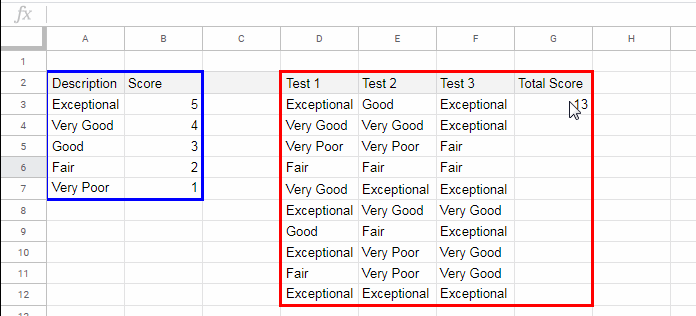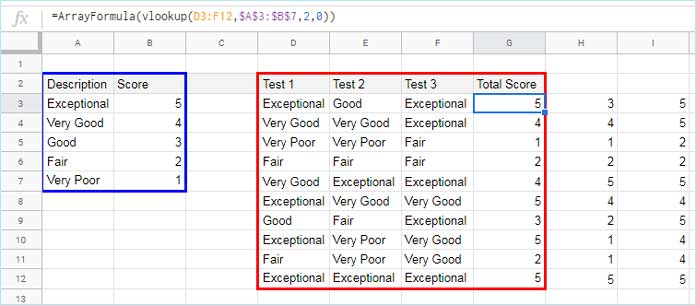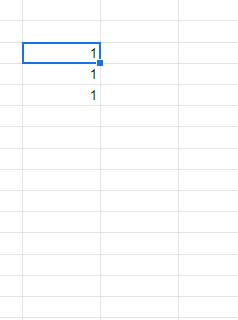We can’t sum text values in Google Sheets or any other spreadsheet applications without assigning numeric values to the texts.
For example, I have a table with employee ratings in text. The texts used for the ratings are “Exceptional”, “Very Good”, “Good”, “Fair” and “Very Poor”.
Each of these text values has scores 5, 4, 3, 2, and 1 respectively.
Table # 1:
| Name | Test 1 | Test 2 | Test 3 | Total Score |
| Christina | Exceptional | Good | Exceptional | |
| James | Very Good | Very Good | Exceptional | |
| Bobby | Very Poor | Very Poor | Fair | |
| Amy | Fair | Fair | Fair | |
| Joseph | Very Good | Exceptional | Exceptional | |
| Beverly | Exceptional | Very Good | Very Good | |
| Nicholas | Good | Fair | Exceptional | |
| Paul | Exceptional | Very Poor | Very Good | |
| Kenneth | Fair | Very Poor | Very Good | |
| Janice | Exceptional | Exceptional | Exceptional |
Let’s see how to assign scores to the above 5 types of text values and sum text values in Google Sheets. I am using Vlookup and Sum for these.
If you want to sum the text values like numbers in each row in Google Sheets, you can use the Vlookup + Sum copy-paste formula or a Vlookup + Mmult array formula.
The easiest method to sum text values based on assigned numbers in Google Sheets is by using the non-array Vlookup + Sum. So let me start with that.
Formula Logic and Spreadsheet Preparation
There are two steps in the formula. Understanding that will help you write the formula very easily. They are;
- Assigning scores/numbers to text –
Vlookup. - Sum text values –
Sum(Vlookup).
To sum text values we must first assign scores to text. How to do that?
The Vlookup takes care of assigning numbers here scores to text values. For that, you need to create a table (called ‘range’ in Vlookup) first.
The range contains the text values in one column and their corresponding scores. See that table which will acts as the ‘range’ in Vlookup.
Table # 2:
| Description | Score |
| Exceptional | 5 |
| Very Good | 4 |
| Good | 3 |
| Fair | 2 |
| Very Poor | 1 |
Our task is to assign the scores in Table # 2 to the corresponding values in Table # 1 and get the sum in the Total column in Table # 1.
Non-Array Formula to Sum Text Values in Google Sheets
Vlookup to Assign Scores to Corresponding Text Values
As I have mentioned, the first step to sum text values similar to numbers is to assign numbers to text values.
The following Vlookup will do that.
=ArrayFormula(vlookup(D3:F3,$A$3:$B$7,2,0))
The Vlookup takes multiple search keys from D3:F3 and so I have used the function ArrayFormula with Vlookup.
The ‘range in Vlookup is $A$3:$B$7 and the index (output) column is column 2 in $A$3:$B$7.
The above Vlookup assigns scores 5 to the text “Exceptional”, 3 to “Good” and again 5 to “Exceptional”.
Sum Vlookup Assigned Scores
The Vlookup is in cell G3. Just use the Sum function to sum the numbers returned by Vlookup.
Then drag the formula down.
=ArrayFormula(SUM(vlookup(D3:F3,$A$3:$B$7,2,0)))
This way you can sum text values after assigning scores to it in Google Sheets.
Note: Thre may be a chance of #N/A! error with the above formula in case there is any typo/blank cell in Table # 1.
To prevent that include IFNA with the above formula. You must insert IFNA before the SUM.
=ArrayFormula(SUM(IFNA(vlookup(D3:F3,$A$3:$B$7,2,0))))Array Formula to Sum Text Values in Google Sheets
With some tweaks, we can make the above formula as an array formula.
The first change is in the Vlookup. In the above example, the search key is from the array D3:F3. Make it D3:F12.
=ArrayFormula(vlookup(D3:F12,$A$3:$B$7,2,0))
Here also you must wrap the Vlookup formula output with IFNA to return 0 in case of #N/A! This is a must for MMULT to work properly.
=ArrayFormula(ifna(vlookup(D3:F12,$A$3:$B$7,2,0),0))The MMULT is for returning the matrix product of two matrices, right?
Syntax: MMULT(matrix1, matrix2)The above formula is ‘matrix1’. We don’t want to calculate the product of two matrices and we don’t actually have ‘matrix2’.
Let’s generate ‘matrix2’ by using the Sequence formula as below.
=ArrayFormula(sign(sequence(3,1)))This formula would return the number 1 thrice in a column (in 3 rows). You can test it on your sheet.

The number of columns in ‘matrix1’ is 3. So as a standard, ‘matrix2’ must contain an equal number of rows. We have now compatible matrix sizes in MMULT.
If you have more columns in your Table # 1, change the Sequence formula accordingly.
Here is the array formula in cell G2 to sum text values like numbers in Google Sheets.
=ArrayFormula(mmult(ifna(vlookup(D3:F12,$A$3:$B$7,2,0),0),sequence(3,1)^0))Want to use an open array, like D3:F instead of D3:F12?
Read this guide – Proper Use of MMULT in Infinite Rows in Google Sheets.
Thanks for the stay. Enjoy!






















Amazing Prashnath!! Thank you so much for this.
Is there a way that the formula brings the most common word/text used??
I’m doing a matrix to prioritize features. I’m using a “must-have won’t have” criteria.
In the end, if we have more “must-haves,” we will do it.
Rather than having the output, this is a 95 score feature.
Does that make sense?? thanks in advance
Hi, Luiz Gattaz,
I don’t know how your data is formatted. I assume the said two strings are spread in the range B2:D10.
If so, insert the below formulas in F2 and G2, respectively.
F2
=UNIQUE(flatten(B2:D10))G2
=ArrayFormula(countif(flatten(B2:D10),unique(flatten(B2:D10))))If that doesn’t help, feel free to share a sample sheet via “Reply” below. I won’t make it public.
Thanks for this! I’m using this in our employees’ leave tracker. However, whenever I add the SUM function, I get an error ‘did not find value in VLOOKUP evaluation’ I’m not sure what’s wrong.
Hi, Jenny,
To verify your formula personally, you can consider leaving your sheet link via “Reply”. Before publishing, I will remove the link from your reply.
Thanks for this, has been very helpful. I’m using it to automatically score a multiple-choice test from google forms where each multiple-choice has a different score (not just right or wrong).
The trouble I’m having now is that the cell with the formula seems to be deleted each time a new form is submitted, therefore it doesn’t auto-complete. Do you know why this could be?
Hi, Ed,
Avoid using any formula in the ‘form response’ tab. It may cause issues with array formulas.
As a solution, add a new sheet tab and do your data manipulation on that.
For example, if your form response tab and data range is
'form response'!A1:D, in the newly added sheet use the below formula in cell A1.={'form response'!A1:D}